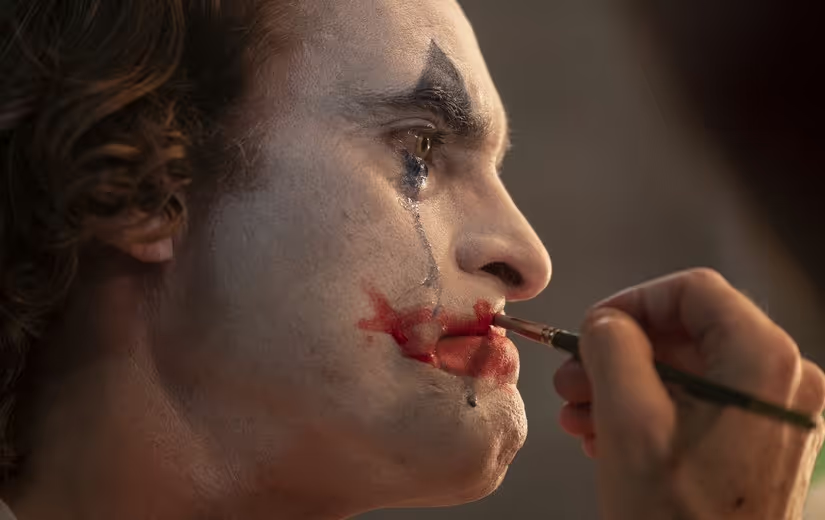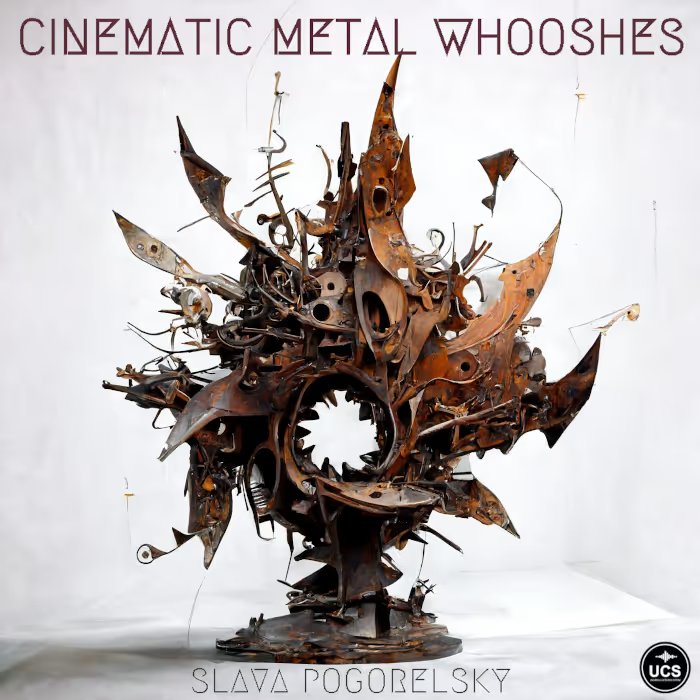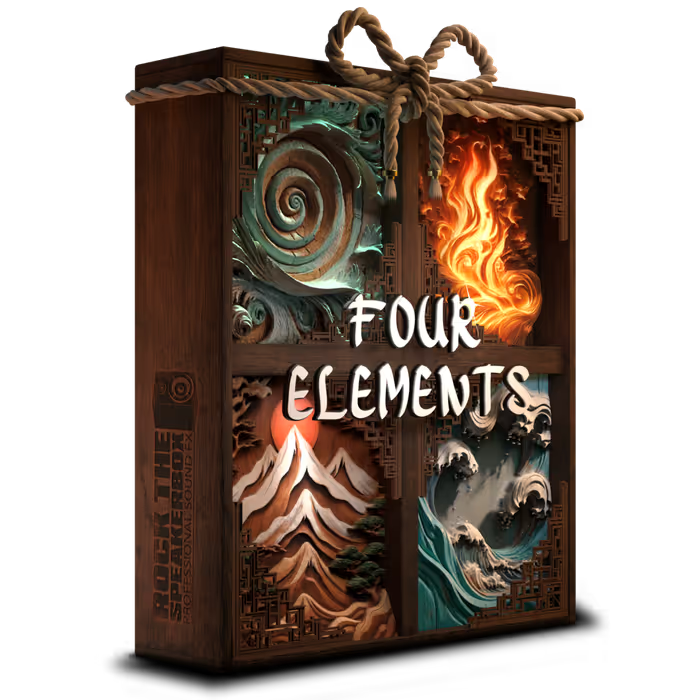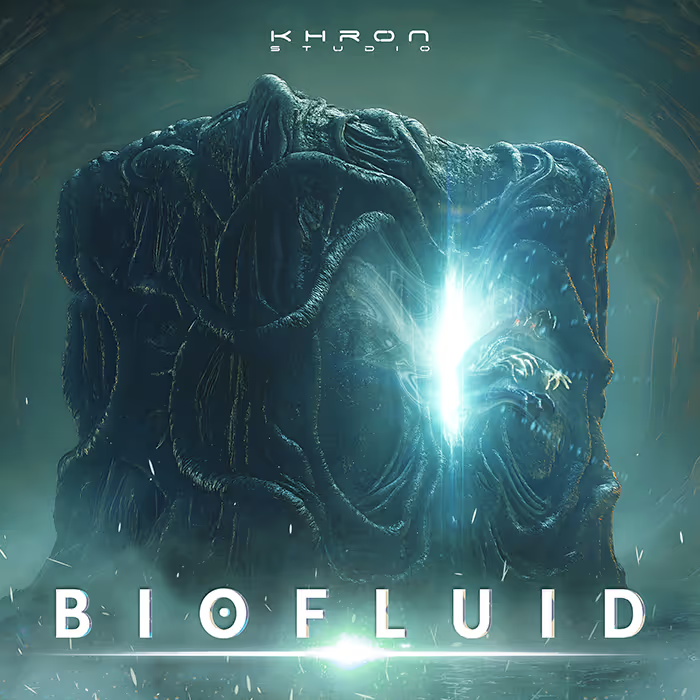Here, Warner Bros. Sound’s Oscar-winning Supervising Sound Editor Alan Robert Murray shares details on how he and the sound team brought Gotham City to life with custom recordings and era-appropriate effects, how they used sound to support Phoenix’s performance intensity, and how they subtly blended the sound and score to create a visceral, cruel, and crazy world.
The trailer for ‘Joker’
It was an experience that left me with two words: gritty and uncomfortable. No, it wasn’t a trip to the Jersey shore. Warner Bros. latest DC film Joker — in theaters now — made an impression upon me that didn’t fade as the house lights came up. Joaquin Phoenix’s brilliant performance as Arthur Fleck, aka Joker, was disquieting. Unsettling. It was equal parts sad and truly insane. Phoenix succinctly communicated Arthur’s grating reality, his struggle with sanity, and his ultimate dive into insanity within the film’s 2-hour time frame. He left nothing on the table.
Joker isn’t a flashy, fantastical comic-book film. There are no superpowers that defy the laws of physics or disrupt the norms of our natural world. So the sound needed to convey Arthur’s insanity while staying subtle and realistic. Warner Bros. Sound’s two-time Oscar winning supervising sound editor Alan Robert Murray in Burbank, CA, created a noisy, tense Gotham City for Arthur’s world. It isn’t a wash of ambience. It’s an active, angry, worn-out sounding city, carefully crafted with discrete sounds strategically placed in the Dolby Atmos surround field. In this reality, Murray places squirm-inducing details, like the sound of Arthur’s hand running lightly over a child’s paintings. It’s so small yet so disturbing.
Here, Murray talks about his collaboration with director Phillips and film editor Jeff Groth, how they used effects in conjunction with composer Hildur Guðnadóttir’s score to enhance the tension in the film, and how Foley, field recordings, and loop group added distinctive texture to the soundtrack.
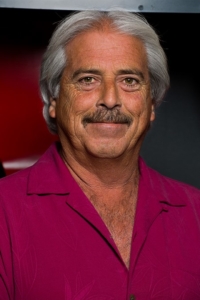 Interestingly, Director Todd Phillips’s filmography is filled with comedies. He directed The Hangover trilogy, Starsky & Hutch, Due Date, and Borat. How did Phillips’ directing experience influence his approach to Joker?
Interestingly, Director Todd Phillips’s filmography is filled with comedies. He directed The Hangover trilogy, Starsky & Hutch, Due Date, and Borat. How did Phillips’ directing experience influence his approach to Joker?
Alan Robert Murray (AM): This is the first time that I had the pleasure of working with Todd so I can’t comment on his prior films. But I can say that in the initial meetings with Todd and film editor Jeff Groth, they had a very well-defined, thought-out plan of attack regarding sound elements that were to go into Joker. They stressed at the beginning that there had to be a 3-D quality to the mix, to make the audience feel like they were in the middle of Arthur’s descent into madness. Right off the bat, there was the feeling that Gotham is a city on edge; it has a threatening atmosphere. The effects had to incorporate some dynamic reality and subtle sound design to blend with composer Hildur Guðnadóttir’s score.
… each scene had to start with a degree of normalcy that built like a symphony in sync with Joaquin Phoenix’s intensity and his reaction to what he was going through.
So they laid the groundwork that each scene had to start with a degree of normalcy that built like a symphony in sync with Joaquin Phoenix’s intensity and his reaction to what he was going through. So we started the whole premise on those rules.
It was so well defined by the time it got to me. It was nice to have guidelines for what Todd wanted for the movie. That gave us a track to follow and that was pretty cool. They had a lot of discussion before I came onto the scene.
In an interview for IMDb, director Phillips had said, “If back in 1979 they were making comic book movies, that’s what we wanted [Joker] to feel like.” How did this translate into what he wanted in terms of sound?
AM: Again, we had to convey the grittiness of Gotham (although it really looks like New York City). The time period is mid-seventies, so in the opening chase with Arthur and the kids who stole his sign, all the cars had big V-8 engines and exhaust rumbles, and we were trying to convey that loud, aggressive sound of the city.
We wanted to get that dirty, gritty, city-on-edge sound for Gotham.
Arthur’s apartment was always alive with people yelling from the alley, noise from his neighbors in the hallway, unique sirens and aggressive horns. We wanted to get that dirty, gritty, city-on-edge sound for Gotham.
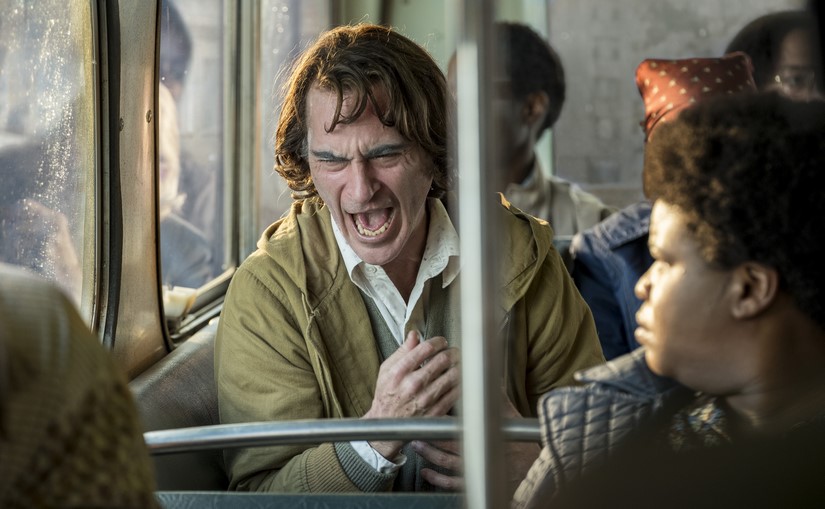
One thing I loved about the street scene (as Arthur is spinning his sign on the sidewalk) was the specificity of sound. You discretely hear the people passing by. To the left, you hear the sounds of the cars passing by. Did you have a lot of discrete sound elements for the mixers to pan?
AM: Everything was specific with a lot of detail. Another direction for Joker was: don’t make it muddy. Have lots of details.
We used these big V-8 engine sounds to wipe the frame, between the cuts of the kids running and Arthur chasing them. We focused on the Foley footsteps of them running, and the aggressive horns as they’re crossing the street through traffic. It was all about setting up the time period we’re in, and that this city is ratty and gritty. We were following the guidelines of what Todd wanted to bring into this movie.
Another direction for Joker was: don’t make it muddy. Have lots of details.
The ADR and group lines were all coming from Todd, like when the neighbor yells, “Shut up!” through the apartment wall. We wanted to communicate the fact that this city is always alive.
One night, we took a big ADR group onto the backlot set of New York City here at Warner Bros. so we could get that natural reverb off the buildings. We had recording crews on rooftops, in doorways, and hanging out of windows, trying to get the natural reverb you would hear from the alley. We had a lot of alley yell-outs and arguments all throughout Arthur’s apartment. Todd wanted that realistic sound that you could only get in New York City.
We also built the crowd from that night into the end riot, where we had a specific feeling of anger that we wanted to portray. It was all pre-planned and figured out. That’s what I loved about this movie, that everybody had a concise idea of what we wanted to put into it.
[tweet_box]Designing the dark sound of Joker – with Oscar-winning Sound Supervisor Alan Robert Murray[/tweet_box]
There’s a scene in which Arthur is sitting on his mom’s bed, watching the Murray Franklin (Robert De Niro) show on TV. It starts as a broadcast but then it goes into Arthur’s headspace as he’s fantasizing about being on the show. Can you tell me about your sound work on that scene?
AM: Going into the ‘live’ part of the Murray Franklin show — although the viewer doesn’t know if it’s real or not real, and that’s something that happens often throughout the film — we wanted the audience to feel like they’re in the middle of the studio audience. By placing the crowd reactions discretely around the Dolby Atmos surround field, we can make the audience feel like they were with Arthur sitting in the middle of this studio audience. We have the sound totally surround the audience and it follows the angle of the camera. It was specifically mixed to do that, to put you there with Arthur.
Going from the show back into the bedroom with Arthur and his mom watching TV, we used sound design but we were always conscious of not overdoing it. We blended our sound design with Hildur’s transition back into the apartment; it was a careful blend. We had some more extravagant sound design elements at that point like big whooshes but Todd was very conscious about getting in to and out of things subtly. So we took Hildur’s lead and made our sound design work with that.
Hildur Guðnadóttir, on composing the music for Joker
For the subway conflict, in which Arthur kills those three guys, how did you use sound to help intensify that sequence?
AM: There, we built it like a symphony. It gets bigger and bigger and then it ends with the gunshots. We started subtle and built the tension relative to what’s happening around Arthur.
The first time you notice something strange about the environment, we start off with the blinking lights. That lets you know that this isn’t a normal subway train ride. We introduce more low-end rumble into the subway car as the scene gets more intense. Then, we introduce the train-bys on the opposite tracks, which were made up of jet-bys and other elements that lent an aggressive, sinister sound. It builds with the intensity that Arthur is feeling, to a symphony-like crescendo with the gunshots.
… Todd was very conscious about getting in to and out of things subtly. So we took Hildur’s lead and made our sound design work with that.
When the gunshots rang out, it had to hit you hard. We had to emphasize that it finally happened; Arthur finally put an end to all of the abuse he’s been going through.
When Arthur gets off the train, we have the gunshots echoing down the tunnels of the subway station. This triggers Arthur’s tinnitus design that we put in there to reinforce what happened and signal the beginning of his descent into becoming the Joker.
That was one of my favorite scenes because of the way we build it and mixed it. It took a lot of detail and a lot of planning to determine what speakers we were going to put the sounds in. And then we brought Hildur’s score in right before the gunshots. It was a great joint effort on everybody’s part when we were on the stage mixing that scene.
This scene was great; we had the subway train get more sinister and terrorizing as we go through the progression and then the score comes in and we have everything hit. That was really cool.
I can’t think of a movie I’ve done recently where more thought went into the mix and the way things were positioned.
Again, this was planned and carried out by everybody on the team. I can’t think of a movie I’ve done recently where more thought went into the mix and the way things were positioned. Working on this film was a great experience.
After the murders, Arthur retreats to a public restroom. The rhythmic buzzing of the neon lights acts like a dance track to which he does those Tai Chi-esk moves. Can you tell me about the design of that scene?
AM: Again, the direction here was to make it subtle and make it almost part of the score that we were hearing. We couldn’t use normal sounds. We used processed hummingbird-bys to make these zuzzes that were just subtle enough to be there but without overtaking the scene. The scene was about Arthur transgressing into this dance to make himself feel better after what just happened. He was going into himself and shielding off all the horror that just happened in the subway. There was a lot of talk and planning about this from Todd and Jeff.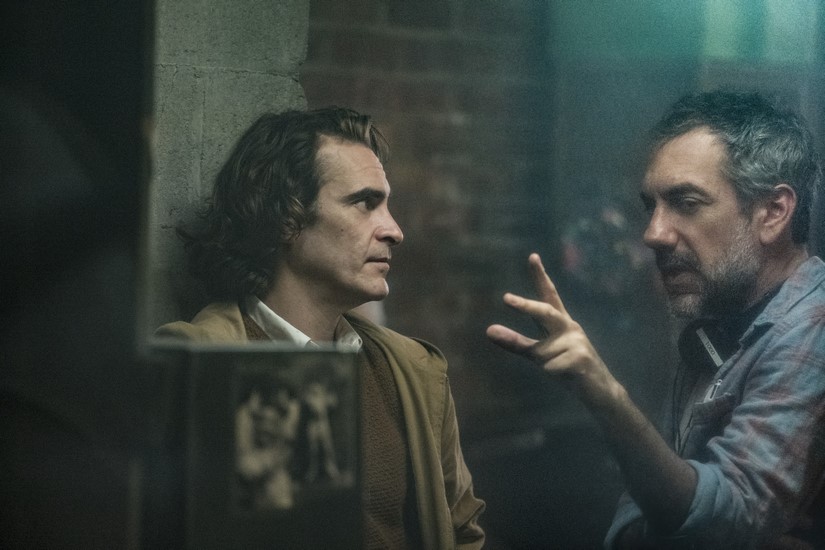
His dance in the bathroom was extremely unsettling. His reaction to the murders was more disturbing to watch than the murder scene…
AM: It was almost like a celebration; now he’s gone over that plateau. It was eerie. That’s part of the uniqueness of this movie, dealing with Arthur’s mental state and how we as an audience react to it.
That’s part of the uniqueness of this movie, dealing with Arthur’s mental state and how we as an audience react to it.
Kudos to Todd and everybody for doing that.
I heard that dance wasn’t planned. I remember hearing Todd talk about how that was an impromptu performance. It turned out really freaky.
When Arthur stabs his clown buddy Randall (Glenn Fleshler) with the scissors it was so visceral. Can you tell me about your sound work on that scene?
AM: Yeah, that was the direction, to make it real and horrifying and disturbing. With all of the talk about violence that came along with this movie (which I thought was so unfounded and wrong because it’s just a movie and there is more violence on TV shows than what you saw in Joker), kudos to Todd for not backing down. I noticed that in some instances when you do this type of sound work, people get worried and scared about it. They wonder if it should be toned down, with less blood and guts. But Todd wanted to show it for what it was, so we went in that direction of horrifying and horrible and dynamic. It’s nice to see someone follow through with a scene rather than be afraid of it.
We wanted to have the horrific sound of the scissors going into the guy’s eye, and making sure we had the real sound of someone getting their head banged against a wall that violently…I wanted to get that vicious quality, to put the audience in that moment of horror and terror.
Sound-wise, that scene was built with effects as opposed to Foley. We wanted to have the horrific sound of the scissors going into the guy’s eye, and making sure we had the real sound of someone getting their head banged against a wall that violently. I actually recorded that sound in my own house, and in doing so put a few dents in my wall. I put some contact mics on the other side of the wall to capture a more reverberant sound. I also used a Neumann M/S mic that I’ve been using for the past five years. I always get great results with it. I wanted to get that vicious quality, to put the audience in that moment of horror and terror. Then, the brilliant part was playing it off with the midget trying to get out of the apartment but he couldn’t reach the lock. You go from one degree of moviemaking to another. I thought it was brilliant.
I believe in going the extra mile to answer what the director’s really after and trying to decipher what’s in his head. I think you have to do that, especially on a movie like this where it’s easy to overdo something and therefore subtract from the perfection of the scene. We decided to go all the way and let the director bring it down to a level that he’s comfortable with.
Soundworks Interview: Academy Award-winning sound supervisor Alan Murray and re-recording mixers Tom Ozanich and Dean Zupancic discuss how they used impressionistic sound design to take the audience inside Arthur Fleck’s mind. They also deconstruct the film’s centerpiece subway confrontation and let the audience in on how a simple door creak can unnerve an audience. In the second part of this conversation, production sound mixer Tod Maitland discusses the challenges of capturing a gritty and disturbing 1970s Gotham City on the streets of a very modern-day New York.
Arthur goes dancing down the stairs on his way to the Murray Franklin show. After the music montage, the sound design takes over. How did you compose that scene with sound? What was your direction there?
AM: We wanted to get right back into the sound of the city so we started with distant fire engine sirens and the powerful V8 engines of the car-bys to get you into the chase sequence.
We wanted to stress that this was a city going through major chaos; there were alarms, breaking glass, and sirens all working in conjunction with the music.
We wanted to make it exciting and dynamic. We added growls on the car-bys to shift gears into the intense chase scene. We had over exaggerated footsteps on the metal stairs and the subway trains were bigger than in reality, to throw you into the chaos of the city. We used that moment to shock the audience back into reality.
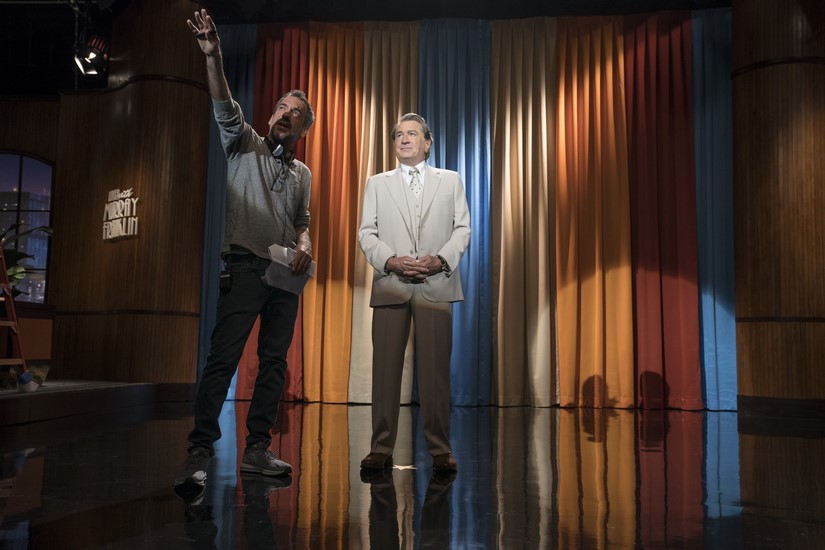
For the clown riot on the streets of Gotham, after Arthur gets arrested, how did you approach that sequence?
AM: We wanted to stress that this was a city going through major chaos; there were alarms, breaking glass, and sirens all working in conjunction with the music. We wanted to make sure we got the detail through. The toughest thing about that sequence was coming up with sirens that would work with “White Room,” which I have to tell you is one of my favorite songs. We wanted to make sure that the timbre of the sirens and the music all worked together and didn’t take away from each other so we could get the impact of both.
After the accident, we go into the subjective/surreal design of the crowd. We went a little more nonspecific at that point because it’s about the slowed down motion of the cinematography. At the end of the riot, when Arthur gets up on top of the car, we didn’t want to make it specific at that point. We could have had tons of ADR people chanting, “Joker! Joker! Joker!” But it was more of a crowd roar than specific lines now that Joker has come into fruition. There is this primal scream that came out of Arthur and the crowd. Where you could go one way, we went the opposite. That worked really effectively.
There was some really nice Foley work too, like the leather creak of Arthur’s clown shoe as he’s struggling with it in the locker room, and the way he touches and rubs everything in Sophie’s (Zazie Beetz) apartment, and the uncomfortable way he rubs his pants and bounces his leg in the social worker’s office. Who did your Foley? What can you tell me about Foley’s contribution to the film’s sound?
AM: The Foley team was one that I’ve been using for the last 10 or 15 years, called One Step Up, which is Dan O’Connell and John Cucci. They’ve done remarkable work for me on American Sniper and on all of Taylor Sheridan’s movies.
The Foley team was… One Step Up, which is Dan O’Connell and John Cucci. I can count on them for conveying the sound of the character in their Foley and for recording everything so it works perfectly with the scene.
I can count on them for conveying the sound of the character in their Foley and for recording everything so it works perfectly with the scene. They’ve been a big part of my sound crew in all of my movies.
The sound of Arthur struggling with his shoe in the locker room was actually production sound. That was really Joaquin doing that, ripping that shoe as loud as he could. Kudos to production sound mixer Tod A. Maitland for making sure he recorded sounds like that and for getting the mic in there because I know it’s tough during filming.
I had contacted Tod prior to the end of filming because they had shot all of this in New York and there was the question of whether I could go there and record the city, to add its grittiness into the mix.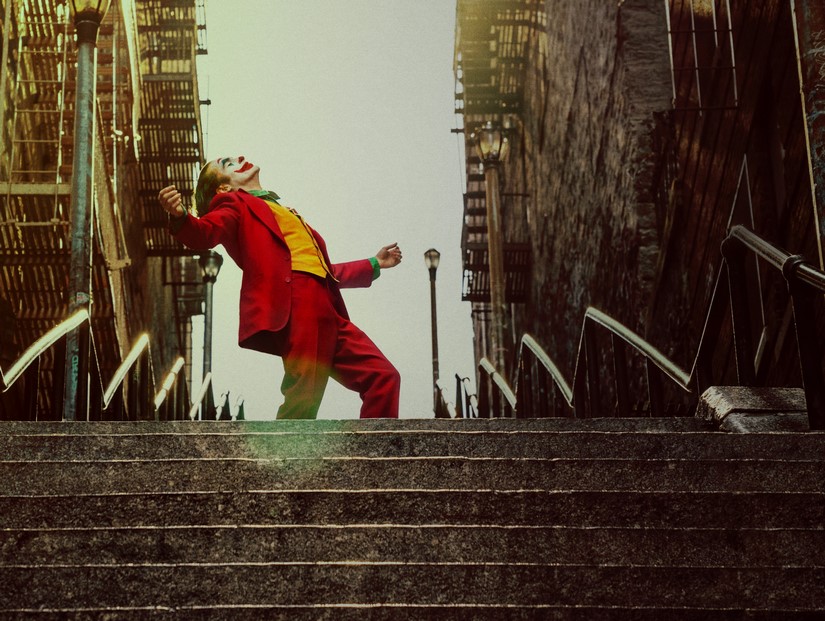
I couldn’t go to New York but since Tod had just finished shooting I was able to give him a list of things to record for me. I sent over a pretty unique mic that we had discovered a few shows ago. It’s an ambisonic mic that records in 4-channel atmospheric all around. So he got that mic and he went out late at night and captured the sound of the New York subways which you just can’t get here in California. You can turn the recordings into a 7.1 representations and that helped when creating the sounds for all around us. He also recorded the sounds of people yelling inside apartment buildings at night. He rode the El trains and recorded those. His work was a great contribution to the film, too.
When Arthur walks into Sophie’s apartment and touches the child’s paintings, that was Foley. They really captured the sound of the paper that a child’s artwork would be on. Dan and John just get it. They know that paper is going to have a distinct sound and they get it right.
Again, everybody brought their A-team to this film and I’m so proud of all of their effort.
What was the most challenging scene for sound? Or, did you have a favorite scene for sound?
AM: I think the subway scene is it because it’s the beginning of Arthur going into that deep place. We took the time to make sure we built that like a symphony, which we all talked about.
Also, the riot scene at the end of the movie was a challenge, finding elements that would play well with “White Room” and leaving room for details in both the music and the sound effects. I think we did a good job of making sure that both got through without making that scene a muddy mix. That was the most interesting thing about the whole job, was taking time to get the details through.
What are you most proud of in terms of sound on Joker?
AM: It was the way this movie had been set up from the beginning. The director, the editing, and the cinematography were all incredible. Everybody realized this was a special movie and everybody brought their A-team and worked in unison. I think that was the greatest thing, that we all worked as a group to accomplish what the director wanted and I think we succeeded. That’s a good feeling at the end of the day.

